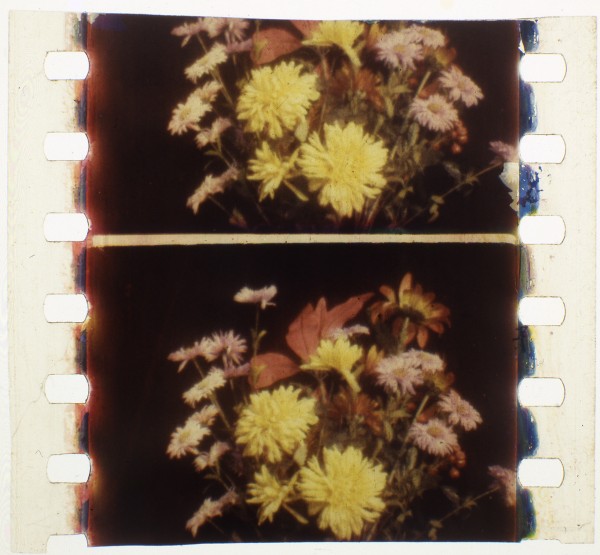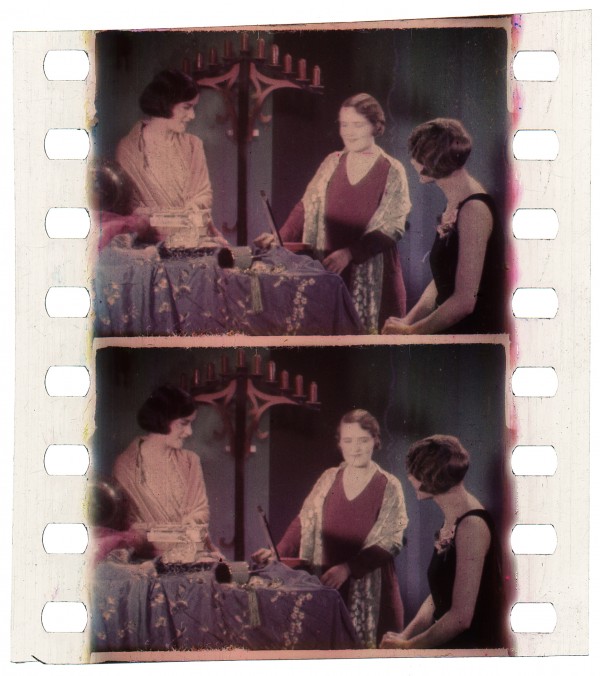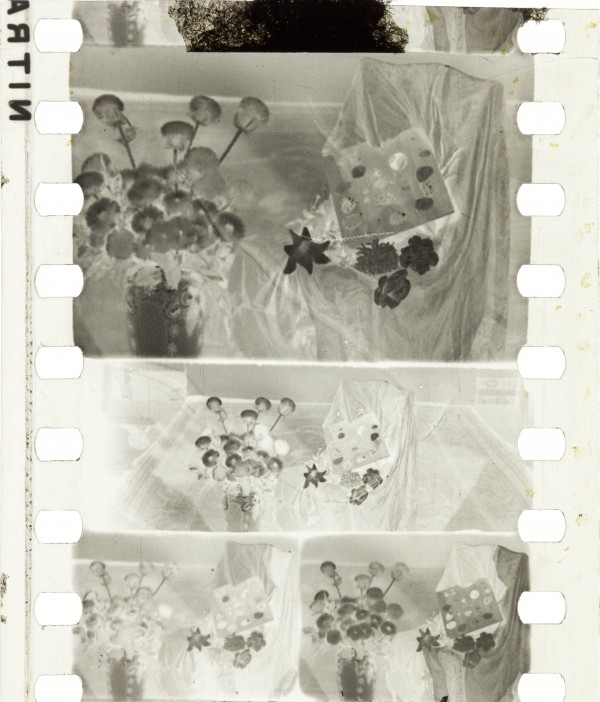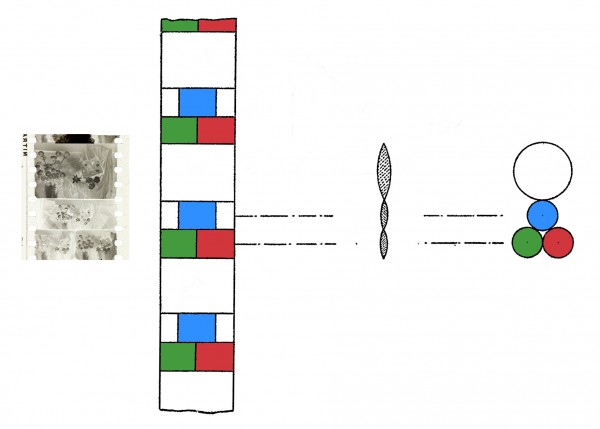A two- or three-colour subtractive process invented by T. A. Mills in the United Kingdom.
Film Explorer

Unidentified film, c. 1930. Three-colour Zoechrome prints were made via a complicated printing process. A B/W key image was first printed and processed. Next an additional emulsion layer was applied on top of this image, exposed with one of the colour records, and was then fixed, bleached, washed and dyed in its complimentary colour. This superimposed a dye image over the B/W key image. These steps were repeated two more times with the remaining colour records, to create a full-colour print.
Cinémathèque française, Paris, France.

Unidentified demonstration film, c. 1930.
Film Technology Frames collection, George Eastman Museum, Rochester, NY, United States.

Unidentified production, c. 1929. The Zoechrome negative contains four frames for every colour frame on the print. A camera with four lenses captured a full aperture B/W frame on the top, and three smaller lenses below, in a triangular formation, captured colour information by filtering the light through red, green and blue filters. These four records were combined and overlaid when making the print. For each exposure, the camera advanced the film eight perforations.
Kodak collection, National Science and Media Museum, Bradford, United Kingdom. Photograph by Barbara Flueckiger in collaboration with Noemi Daugaard. Timeline of Historical Film Colors. https://filmcolors.org/galleries/kodak-film-samples-collection-zoechrome/
Identification
Approximately 23.6 mm x 17.7 mm (0.93 in x 0.70 in).
All surviving film samples are silent full aperture.
Prints contain multiple layers of emulsion, each applied and exposed one-at-a-time during the processing stage.
None
1
Colours are muted and pastel. Skin tones are pale. Fringing is often apparent.
A four-lens camera captured four frames of different sizes simultaneously. The largest frame was approximately 23.6 mm x 17.7 mm (0.93 in x 0.70 in). The next smallest frame measured approximately 23.6 mm x 8.9 mm (0.93 in x 0.35 in). The two smallest frames measured approximately 11.8 mm x 8.9 mm (0.47 in x 0.35 in).
“Eastman regular negative [was] panchromatized at the Zoechrome Laboratory with their own sensitizing solutions.” (Sponable, 1930)
Standard 35mm Eastman Kodak edge markings.
History
Zoechrome was developed by Thomas Albert Mills over an extended period. He first patented a successive-frame system for two- or three-colour cinematography in December 1911. This was a complicated system in which, for two-colour, successive images were captured through blue and orange filters. After printing the successive frames were toned blue and orange and then the film was coated with emulsion on the back and the same images printed one frame out of register and toned identically, so behind each blue-toned frame on the print was an orange-toned frames. Zoechrome Ltd was registered in February 1912 with a nominal capital of £15,000 in £1 shares to acquire the rights to Mill's patents.
The first public demonstration of the process took place on March 12, 1929 at the New Gallery in London, featuring footage of the sea, country lanes and flowers. Despite a favorable review the following day in The Times, the company appears to have never traded and an official receiver was appointed in April 1931. When the process was offered for sale in 1932 there were no buyers and it ceased development.
[Reprinted from © Brown, Simon (2012). Technical Appendix. In Color Films in Britain. The Negotiation of Innovation 1900–55, Sarah Street (ed.), p. 287. London: British Film Institute, an imprint of Bloomsbury Publishing Plc. Used with permission.]
Technology
From 1921 the process was significantly revised and by the time it was first demonstrated in 1929 it used one large and three smaller lenses. Successive frames were registered, one through the large, normal-sized lens creating a full-frame picture, and the next through the three smaller lenses resulting in three small images registered on a normal-sized frame. This created a negative which alternated between one full-sized frame and one frame with three smaller images.
Each single frame image was printed to produce a black-and-white print of the full-frame image. This was then fixed with varnish and then recoated with emulsion. One of the three smaller images was then enlarged and printed over the full-frame image in register. The print was then dye-toned with the correct subtractive colour, and the process repeated with the other two colours. The function of the single, black-and-white full-frame image was effectively to override any parallax issues from the three smaller images, the larger one being much clearer and more dominant.
[Reprinted from © Brown, Simon (2012). Technical Appendix. In Color Films in Britain. The Negotiation of Innovation 1900–55, Sarah Street (ed.), p. 287. London: British Film Institute, an imprint of Bloomsbury Publishing Plc. Used with permission.]

“The camera is fitted with four lenses which all register at the same instant. Three of these are in a single unit, cemented side by side in the form of a triangle with the fourth just [above]. The four lenses are assembled on one mount so that the four are automatically focused when the mount is racked. The three fundamental color filters are placed respectively behind the three small lens. [sic] The lenses project their quarter size images into a single frame. [...] The fourth lens is a 3" telephoto with a back focus of 1½" to match the other three. It gives a normal size black and white picture in the alternate frames and serves as a black and white key.” (Sponable, 1930)
Modified from: Zoechrome Ltd. (1921). Improvements in or relating to colour kinematography, British Patent GB172,714A, filed September 8, 1920, patented December 8, 1921.
References
Anon. (1912). BT 31/32118/120350, Zoechrome Ltd, 1912, National Archives, Kew, Richmond, United Kingdom.
Brown, Simon (2012). “Technical Appendix”. In Color Films in Britain. The Negotiation of Innovation 1900–55, Sarah Street (ed.), p. 287. London/Basingstoke: Palgrave Macmillan.
Coe, Brian (1981). The History of Movie Photography. London: Ash & Grant.
Cornwell-Clyne, Adrian (1951). Color Cinematography. London: Chapman & Hall.
Flueckiger, Barbara (2012). “Zoechrome”. Timeline of Historical Film Colors. https://filmcolors.org/timeline-entry/1341/ (accessed April 4, 20/24).
Neale, Steve (1985). Cinema and Technology: Image, Sound, Color. London: BFI Publishing.
Cherchi Usai, Paolo (2000). Silent Cinema: An Introduction. London: BFI Publishing.
Sponable, Earl I. (1930). “Film Color Processes” folder. Earl I. Sponable Papers. Rare Book and Manuscript Library, Columbia University Libraries, New York, NY, United States.
Patents
Mills, Thomas Albert & Frank William Kent. 1913. Production of Cinematographic Effects in Colour, British Patent GB191,208,626A, filed April 11, 1912, patented April 11, 1913.
Mills, Thomas Albert. 1921. Improvements in or relating to photographic transfer processes, British Patent GB166,686A, filed April 19, 1920, patented July 19, 1921.
Zoechrome Ltd. 1921. Improvements in or relating to colour kinematography, British Patent GB172,714A, filed September 8, 1920, patented December 8, 1921.
Compare
Authors
Simon Brown is Associate Professor of Film and Television at Kingston University, London, UK. He has written extensively on many aspects of film history and technology – including early, silent and British cinema, 3D and colour cinematography. His publications include the monograph Cecil Hepworth and the Rise of the British Film Industry 1899–1911 (University of Exeter Press, 2016) a Technical Appendix on colour film processes in Colour Films in Britain: The Negotiation of Innovation 1900–1955 by Sarah Street (BFI Publishing, 2012) and the online article “Dufaycolor: The Spectacle of Reality and British National Cinema” (2002) – available at http://www.bftv.ac.uk/projects/dufaycolor.htm.
James Layton is a film historian and archivist specializing in the history of motion picture technology. He is Manager of The Museum of Modern Art’s Celeste Bartos Film Preservation Center, and is co-author of two books with David Pierce: The Dawn of Technicolor, 1915-1935 (2015) and King of Jazz: Paul Whiteman’s Technicolor Revue (2016). Prior to working at MoMA, Layton was an archivist at George Eastman Museum, where he curated two gallery exhibitions celebrating CinemaScope and Technicolor, and the informational website Technicolor 100. He was project manager of the East Anglian Film Archive’s digital film archive and website relaunch in 2011, and also contributed to the Image Permanence Institute’s Knowing and Protecting Motion Picture Film informational poster (2010). More recently, he contributed a significant chapter on Eastman Kodak to FIAF’s expanded edition of Harold Brown’s Physical Characteristics of Early Films as Aids to Identification (2020).
The History, Selected Filmography, Technology and References sections are written by Simon Brown using text reprinted from the Technical Appendix of Colour Films in Britain: The Negotiation of Innovation 1900–55 (2012). All other text was written or compiled by James Layton.
Brown, Simon & James Layton (2024). “Zoechrome”. In James Layton (ed.), Film Atlas. www.filmatlas.com. Brussels: International Federation of Film Archives / Rochester, NY: George Eastman Museum.


